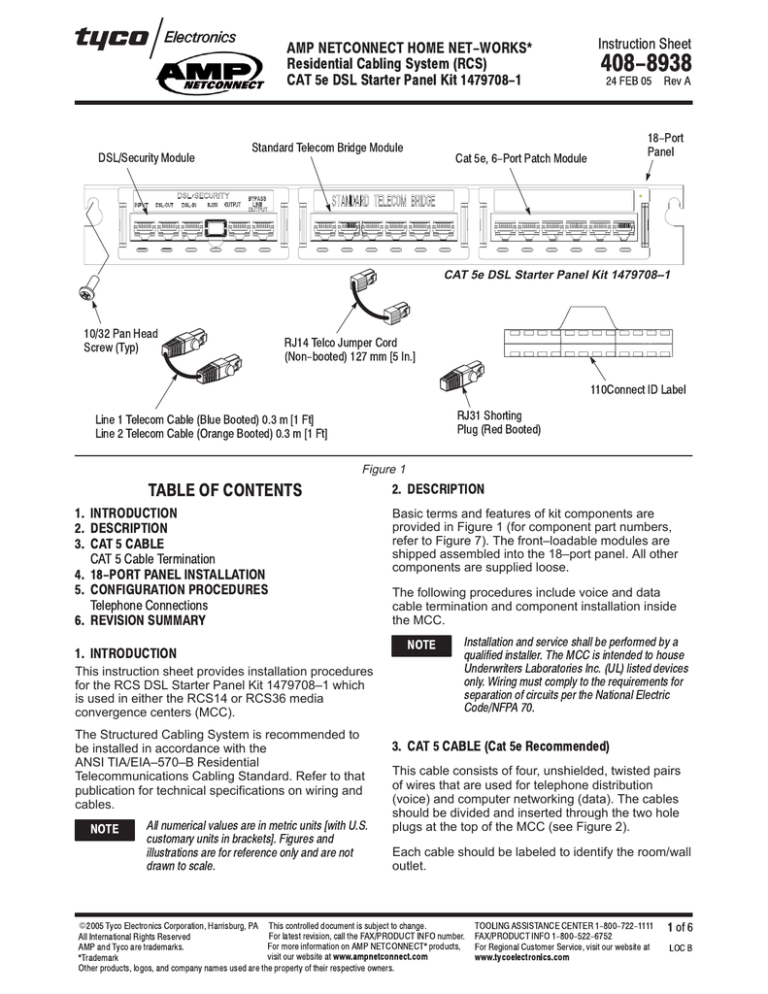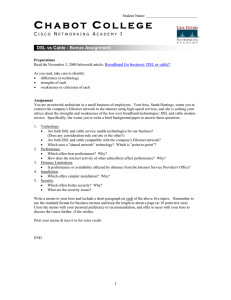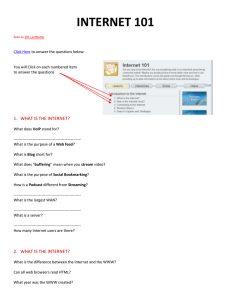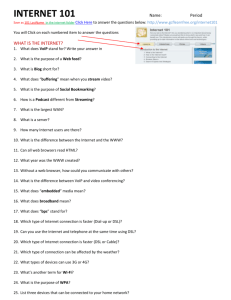
AMP NETCONNECT HOME NET-WORKS*
Residential Cabling System (RCS)
CAT 5e DSL Starter Panel Kit 1479708-1
Instruction Sheet
408-8938
24 FEB 05
Rev A
18-Port
Standard Telecom Bridge Module
DSL/Security Module
Panel
Cat 5e, 6-Port Patch Module
CAT 5e DSL Starter Panel Kit 1479708–1
10/32 Pan Head
RJ14 Telco Jumper Cord
Screw (Typ)
(Non-booted) 127 mm [5 In.]
110Connect ID Label
RJ31 Shorting
Line 1 Telecom Cable (Blue Booted) 0.3 m [1 Ft]
Plug (Red Booted)
Line 2 Telecom Cable (Orange Booted) 0.3 m [1 Ft]
Figure 1
TABLE OF CONTENTS
2. DESCRIPTION
Basic terms and features of kit components are
provided in Figure 1 (for component part numbers,
refer to Figure 7). The front–loadable modules are
shipped assembled into the 18–port panel. All other
components are supplied loose.
1. INTRODUCTION
2. DESCRIPTION
3. CAT 5 CABLE
CAT 5 Cable Termination
4. 18-PORT PANEL INSTALLATION
5. CONFIGURATION PROCEDURES
The following procedures include voice and data
cable termination and component installation inside
the MCC.
Telephone Connections
6. REVISION SUMMARY
NOTE
1. INTRODUCTION
qualified installer. The MCC is intended to house
Underwriters Laboratories Inc. (UL) listed devices
This instruction sheet provides installation procedures
for the RCS DSL Starter Panel Kit 1479708–1 which
is used in either the RCS14 or RCS36 media
convergence centers (MCC).
The Structured Cabling System is recommended to
be installed in accordance with the
ANSI TIA/EIA–570–B Residential
Telecommunications Cabling Standard. Refer to that
publication for technical specifications on wiring and
cables.
NOTE
Installation and service shall be performed by a
All numerical values are in metric units [with U.S.
only. Wiring must comply to the requirements for
separation of circuits per the National Electric
Code/NFPA 70.
3. CAT 5 CABLE (Cat 5e Recommended)
This cable consists of four, unshielded, twisted pairs
of wires that are used for telephone distribution
(voice) and computer networking (data). The cables
should be divided and inserted through the two hole
plugs at the top of the MCC (see Figure 2).
customary units in brackets]. Figures and
illustrations are for reference only and are not
drawn to scale.
E
Each cable should be labeled to identify the room/wall
outlet.
This controlled document is subject to change.
TOOLING ASSISTANCE CENTER 1-800-722-1111
All International Rights Reserved
For latest revision, call the FAX/PRODUCT INFO number.
FAX/PRODUCT INFO 1-800-522-6752
AMP and Tyco are trademarks.
For more information on AMP NETCONNECT* products,
For Regional Customer Service, visit our website at
*Trademark
visit our website at www.ampnetconnect.com
www.tycoelectronics.com
2005 Tyco Electronics Corporation, Harrisburg, PA
Other products, logos, and company names used are the property of their respective owners.
1 of 6
LOC B
408-8938
RCS CAT 5e DSL Starter Panel Kit 1479708-1
The cable bend radius should be maintained
NOTE
throughout cable installation (minimum bend
50.8 mm [2.00 In.] Typ
radius is four times the diameter of the cable).
Allow cable to extend approximately 46 cm [18 in.]
into MCC for termination and mounting of 18–port
panel. Push excess cable back up into wall cavity.
Telecom Cable (Blue Booted
DSL/Security Module
0.3 m [1-Ft]) to INPUT" of
Bypass Line Output
Telecom Bridge Module
Optional SL Modular Jack Termination
DSL In
RJ31X
DSL Out
(T568A Color Code Shown)
Telecom
Bridge
Input
Module
Cat 5e Module
1
Blue
6
White/Blue
Telco Jumper
Orange
Front of
Output
RJ14
White/Orange
18-Port
RJ31
Panel and
Four-Pair Color-Coded
Shorting
Front of
Universal Wiring Label
Plug (Red)
Wall Outlet
Keep Wires Twisted to
(127 mm [5 In.])
Data
Voice
From Telecom
Within 6.0 mm [.24 In.]
Data
Voice
of Termination
Demarcation Jack
(Purchased Separately)
White/Green
External
Green
Brown
White/Brown
Video
Internal
2 + 2 Configuration
Video
2 + 1 Configuration
Recommended Outlet Configuration
Cat 5 Cable
Impact Tool
1583608-1
Insertion
Blade
Cutoff
Blade
Figure 2
CAT 5 Cable Termination
The Cat 5e patch module is terminated to the Cat 5
cables going to the wall outlets. The blue SL modular
jack (included with Demarcation Kit 1479285–1 if
purchased) is terminated to the incoming telephone
service cable entering the MCC.
Figure 3 (cont’d)
Refer to Figure 3 for proper wire stripping and
termination.
2 of 6
Rev
A
408-8938
RCS CAT 5e DSL Starter Panel Kit 1479708-1
Patch Module Termination
50.8 [2.00] Typ
18-Port Panel Mounting Locations
(Use Two 10-32 Screws)
Blocks Correspond to
6
Modular Ports on Front Side
2
4
RCS36 MCC
Back of Panel
5
Cutoff
1
3
Blade
Panel
Latch
Press Inward
Insertion
Latch
Blade
to Disengage
To Remove a Module Unit,
Use Impact Tool 1583608-1
Press Latches Inward Until
(or Equivalent) to Terminate Blocks
Latches Disengage with Panel
Mount ID Label
(T568A Color Code)
Brown
White/Brown
Orange
White/Orange
Green
White/Green
Blue
White/Blue
Color Marks on ID Label
DSL/Security
Module
Cables
6-Port Patch
Allow No More than
13 mm [0.5 In.] to Untwist
Module
Strip Back Minimum
Amount of Cable Jacket
18-Port Panel
Figure 3 (end)
Rev
A
3 of 6
408-8938
RCS CAT 5e DSL Starter Panel Kit 1479708-1
4. 18-PORT PANEL INSTALLATION
Telecom Cable (Blue Booted)
0.3 m [1 Ft]
The RCS14 MCC accommodates two 18–port panels.
The RCS36 MCC accommodates four 18–port
panels. If one or more expansion panels are to be
installed, the expansion panel(s) should be installed
first. Panel(s) should be mounted starting on the
bottom bracket.
1. Before mounting the panel, some components
must be inserted into the BACK of the Telecom
bridge/security module. See Figure 4.
For Clarity, Cables Are Not Shown
DSL/Security
Expansion Cable (Blue, Non-Booted)
Module
0.3 m [1 Ft] (If Expansion Panel Used)
a. Insert one end of the 0.3 m [1–ft] Telecom
cable (blue–booted) into the INPUT port of the
Telecom bridge module. Connect the other end
to the DSL/security module OUTPUT port.
Input
Output
Port
Port
b. Insert one end of the 0.3 m [1 Ft] Telecom
expansion cable (blue, non–booted) (included
with expansion panel – if used) into the
OUTPUT port of the Telecom bridge module.
Panel Positioned Upside Down
Telecom Cable (Blue Booted)
2. Mount panel onto lower brackets with 10/32 pan
head screws, or above expansion panel(s) if used.
0.3 m [1 Ft]
Rear View of 18-Port Panel (Cable Assembly Connections)
NOTE
Carefully position the cables so that they do not
Demarcation Kit 1479285-1
provide stress on the patch modules. Push
excess cable up into the wall.
Blue-Booted,
0.6 m [2 Ft]
Telecom Demarcation
3. Remove Cat 5e 6–port module from 18–port
panel. Feed Cat 5e cables through openings in
18–port panel and trim to proper length.
Cable
Blue SL Modular
Jack
4. Terminate the SL Modular Jack (purchased
separately) and 6–port patch modules according to
Section 3, CAT 5 Cable Termination.
Bracket
Figure 4
5. After patch module termination, snap module
into front slot of 18–port panel and feed excess
cable into wall.
5. CONFIGURATION PROCEDURES
6. Identify each cable and mark the label (not
supplied) accordingly above each port position.
NOTE
Data connections are not covered in this
document. Refer to the procedures provided with
the selected networking equipment.
7. The blue SL modular jack (terminated to the
incoming telephone service cable) should be
inserted into the demarcation bracket and mounted
onto the equipment mounting bracket (not shown).
4 of 6
Refer to Figure 2 for the following connections:
S Insert the red RJ31 shorting plug into the
RJ31X port on the DSL/Security module.
Rev
A
408-8938
RCS CAT 5e DSL Starter Panel Kit 1479708-1
NOTE
blue SL modular jack that is terminated to the
incoming telephone service cable. See Figure 2.
The shorting plug is inserted only if no security
panel is connected to the security port (marked
RJ31X). Either shorting plug or security panel
The
NOTE
must be installed to provide Line 1 service to
output port.
failure. If the bypass line output is connected, the
S If connecting DSL modem, proceed to
Paragraph 5.1, otherwise, connect Telco
jumper (127 mm [5 in.], 2 pair) between
DSL–OUT and DSL–IN ports on the
DSL/Security module.
NOTE
security panel will be unable to seize Line 1.
The six, blue–booted (Line 1), and two,
orange–booted (Line 2), 0.3 m [1 Ft] Telecom cables
are used to connect and configure telephone (voice)
service to each wall outlet.
Either Telco jumper or DSL Modem must be
connected between
DSL-OUT and DSL-IN ports
to provide Line 1 service to output port.
5.1. DSL Modem Connection (Figure 5)
Connect DSL/Security module DSL–OUT port to DSL
modem line input.
NOTE
DSL signal must be present on Line 1 (blue pair).
Connect filtered Line 1 from DSL modem phone
output (if available) to DSL–IN port. If using modem
without a filtered phone output, use DSL microfilter as
shown in Figure 5.
5.2. Line Connections
Insert one end of the .6 m [2–Ft] Telecom
demarcation cable (blue–booted), included with the
demarcation kit, into the INPUT port of the
DSL/Security module. Connect the other end to the
DSL/SECURITY
INPUT DSL-OUT DSL-IN
RJ31X
OUTPUT
DSL Line
Filtered
Input
Phone Output
BYPASS LINE OUTPUT port is available in
the event of a DSL modem or security panel
To configure Line 1, 2, 3, or 4 as the primary telco line
at a selected wall jack, patch the appropriate patch
panel port (corresponding to the desired wall outlet
jack) to a Telecom bridge module using the
appropriate line selection cord.
To identify the primary telco line available at any given
outlet, the patch cord color will correspond to the
following color–code: (Line1 – blue; Line 2 – orange;
Line 3 – green; Line 4 – gray).
Line 3 (green booted - part number 1479005-1)
NOTE
and Line 4 (gray booted - part number
1479006-1) are purchased separately.
If a specific outlet jack is to be designated for an
application utilizing active switching (Ethernet
network, PBX, etc) patch the appropriate patch panel
port to the active switching device using a 568A patch
cable (Cat 5e, 0.6 m [2 Ft], yellow, part number
219246–2 is recommended).
BYPASS
LINE
OUTPUT
DSL/SECURITY
INPUT DSL-OUT DSL-IN
RJ31X
OUTPUT
BYPASS
LINE
OUTPUT
DSL Microfilter
(Normally Supplied by
Service Provider
DSL MODEM
Line
Filtered
Out
Phone
Ethernet Port (RJ45)
to Network Router/Switch
To DSL Modem
WAN Port
(Line Input)
Figure 5
Rev
A
5 of 6
408-8938
RCS CAT 5e DSL Starter Panel Kit 1479708-1
After configuring the telephone lines, use the hook
and loop Velcro cable tie to bundle the cords together.
See Figure 6.
6. REVISION SUMMARY
Per EC 0990–0195–05
S Updated document to corporate requirements
DSL/Security Module
Telecom Bridge Module
S Removed “Blue” from callout in Figure 1
Wall Outlet
Identification
Label
Velcro Cable Tie
(Blue) 0.2 m [8 In.]
Line 1 Telecom Cable (Blue Booted) 0.3 m [1 Ft]
Line 2 Telecom Cable (Orange Booted) 0.3 m [1 Ft]
Figure 6
COMPONENT PARTS LIST
COMPONENT DESCRIPTION
PART NUMBER
QTY PER
KIT
18-Port Panel, Front-Loadable
1479609-1
1
Telecom Bridge Module
1479781-1
1
406337-1
1
1479187-1
3
10/32 Cross-Recessed, Pan Head Screw, Bag of Four Screws
406746-2
1
Line 1 Telecom Cable (Blue Booted) 0.3 m [1 Ft]
219198-1
7
Line 2 Telecom Cable (Orange Booted) 0.3 m [1 Ft]
1479004-1
2
Velcro Cable Tie (Blue) 0.2 m [8 In.]
1375274-6
1
RJ31 Shorting Plug
1375379-1
1
110Connect ID Label
406905-1
1
DSL/Security Module
1375319-1
1
RJ14 Telco Jumper
1375399-1
1
6-Port, Cat 5e, Patch Module
6-Port Interface Housing
Figure 7
6 of 6
Rev
A




